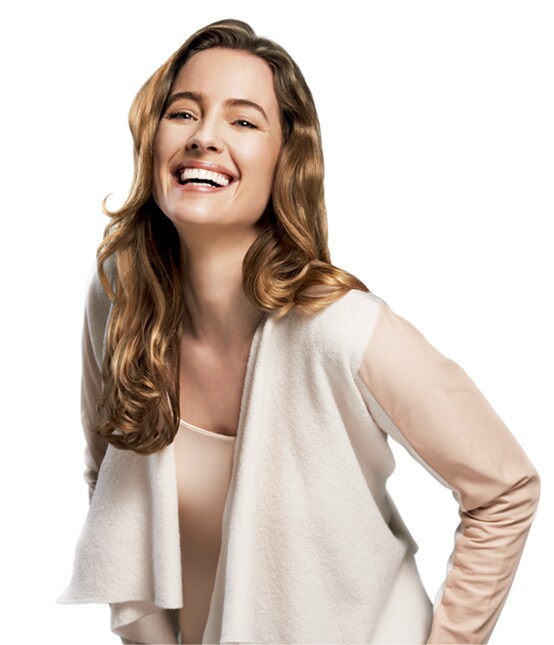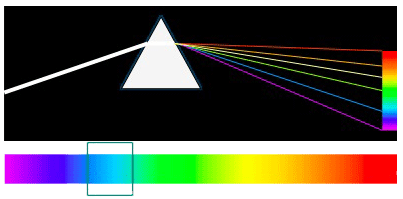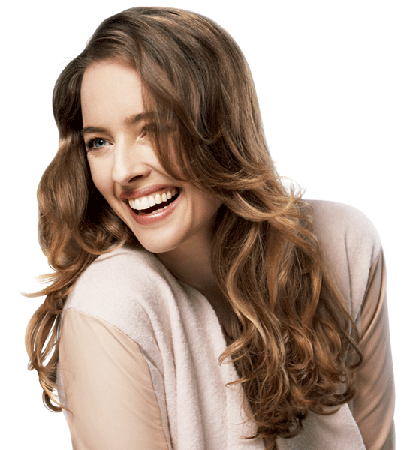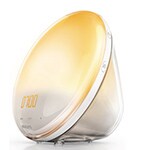Why is light so important to you?
Importance of light
We need light for vision, but light also plays an important role in regulating our sleep-wake rhythm, how we feel and how well we are able to work with our brain.
Read more
Light keeps us in tune with nature
Light during the day and darkness during the night is supporting a good night of sleep and a day full of energy. Most people recognize they feel much more energetic during a bright, sunny, day and often enjoy a sound sleep afterwards. Dark, gloomy days, especially in winter may induce feelings of lethargy, low spirit and sleepiness.
Light makes us feel active
Bright light entering our eyes is increasing our alertness, and decreasing sleepiness, and makes us feel more energetic.

Visible light Light is electromagnetic radiation that is visible to the human eye. Each wavelength is seen as a different colour. White light is made up of all the wavelengths of the visible spectrum.
Light via eyes Light is needed for vision, but light entering eyes also has other non-image forming effects. It is the main Zeitgeber for the biological clock in our brain and it has acute effects on our body and on levels of energy and mood.
Right light at the right time of day Some of the non-image forming effects of light exposure depend on the colour of light in combination with timing of exposure. Some colours and intensities that are beneficial at one time of day may be detrimental at other times of day.
Light and waking up In nature, daily life is initiated by the rising Sun, and comes to rest after the Sunset. Modern society respects different daily schedules, we often need to get up before the sunrise, and continue activities until long after the sun has set.
Sleep patterns In modern society we have the capability to prolong the light part of the day by using artificial lighting. Our bodies are not synchronized to the rhythm of the Sun, but to our lifestyle.

Importance of light
We need light for vision, but light also plays an important role in regulating our sleep-wake rhythm, how we feel, and how well we are able to work and concentrate. Light exposure through our eyes also has a clear effect on our body:
To keep the 24-hour rhythms in our body in sync with the natural environment, we need light at particular times of the day and darkness at other times. Light in the morning induces our rhythms to shift to an earlier phase, light in the evening shifts our rhythms to a later phase.
It is in particular the blue part of the light spectrum that is important for all these "non-image forming" responses.
Light keeps us in tune with nature
Light during the day and darkness during the night is supporting a good night of sleep and a day full of energy. Most people recognize they feel much more energetic during a bright, sunny, day and often enjoy a sound sleep afterwards. Dark, gloomy days, especially in winter may induce feelings of lethargy, low spirit and sleepiness. The reason why some people experience mild changes in energy levels, sleep need, and mood in winter, and others do not, is not really known. Whether it actually is the lack of light that is causing the symptoms is also unclear. What is known is that light exposure through the eyes, either by the sun or by an artificial light source, is able to counteract reduced feelings of well being. In people experiencing seasonal changes, bright light during the short winter days, and in particular during the morning hours, may fight the low energy levels and improve mood. Already 30 minutes of light is capable of increasing subjective energy levels. If one recognizes the annual pattern in feelings of fatigue, increased sleep need and mild mood disturbances in winter, it seems optimal to start exposure to 20-30 minutes of bright light in the morning around breakfast time, as soon as the first signs in autumn appear.
Light makes us feel active
Bright light entering our eyes is increasing our alertness, and decreasing sleepiness, and makes us feel more energetic.
This is so during the day and during the night. In the morning, when the eyes are still adapted to darkness, relatively moderate intensity of light, such as the one of Wake-up Light can be sufficient to activate the body and reduce sleepiness. During the day one needs to seek much brighter light to increase alertness, such as light provided by Philips EnergyLight devices, or of the bright sunny day.
Visible light
Light is electromagnetic radiation that is visible to the human eye. White light is actually made of radiation of different wavelengths. Each wavelength is seen as a different colour. This is visible when you see a rainbow in the sky. Short wavelengths are seen as blue light (~430-500 nm), middle wavelengths as green (~520-565 nm) and long wavelengths as red (~625-740 nm). Our eye has three different photoreceptors (cones) to see these colours and rods that are sensitive to low light levels but not to colours. A separate photoreceptor contains melanopsin and is involved in the non-image forming effects of light. This photoreceptor is most sensitive to blue light with a wavelength of ~480 nm.
Natural daylight includes a continuum of visible wavelengths from about 380 nm to 770 nm. Other light sources, such as fluorescent lamps can have a few prominent peaks in the blue, green and red range rather than smooth spectrum and still be visually percieved in a similar way. Broadband white LED sources typically have a wide peak in blue and even wider peak over the rest of the visible spectrum. Depending on the amount of the different wavelengths in a light source, the white light may be seen as more “cool” (= more blue light) or more “warm” (= more red light).
Computer screens, tablets and smartphones emit a relatively large amount of blue light compared to other artificial light sources. However, when you look at the window during daytime or when you are outside, your eyes are exposed to at least a factor 5 more blue light than when looking at a screen.
Light via eyes
Light is needed for vision, but light entering eyes also has other non-image forming effects. It is the main Zeitgeber for the biological clock in our brain and it has acute effects on our body and on levels of energy and mood. Light information enters the brain through the eyes. In the eye, it first passes the lens and then reaches the retina. The retina is made of several layers of cells. The last layer consists of photoreceptors that are responsible for vision. These are the rods, used for vision under low light conditions, and the cones, used for vision under higher light conditions and colour vision.
On its way to the last layer, light passes through the first layer. This layer contains ganglion cells that integrate all light information from the rods and cones. In addition, some of these cells (approximately 3%) are light responsive themselves. They contain a photosensitive substance called melanopsin that is the responsible component in signalling the light information. Melanopsin is most sensitive to the blue part of the light spectrum.
The cell bodies of these melanopsin cells are quite big and they have a large network of branches to catch all the environmental light information. Information on light and darkness is transported through the optic nerve from the retina to the biological clock in the hypothalamus and to several other brain areas involved in non-image forming effects.
Right light at the right time of day
Some of the non-image forming effects of light exposure depend on the colour of light in combination with timing of exposure. Some colours and intensities that are beneficial at one time of day may be detrimental at other times of day. Exposure to light in the morning, especially light with a more bluish colour, is needed in most people to properly wake up, become energetic and to keep the sleep-wake cycle in synch with the natural 24-hour cycle. This is not the case in morning types; they should try to avoid too high and bluish light in the early morning.
Exposure to light during daytime is beneficial to improve low levels of energy and mood if needed. The more bluish the white light is, the lower the intensity that is needed to reach a response. Too high levels of blue light and definitely exposure of the eyes to UV light should always be avoided to protect the eyes.
Exposure to bright light, and definitely bluish light, in the evening is in most cases not recommended. Most people already tend to go to bed too late and exposure to bright light in the evening even increases levels of alertness. This in turn increases the risk of going to bed later and shorten sleep. Only people who suffer from high levels of sleepiness in the evening and waking up early may be helped by exposure to bright light in the evening.
Exposure to light, and especially bluish light, at night should be avoided as much as possible. It may increase energy levels and reduce sleep, but it may also induce undesirable large phase shifts of the biological clock, and affect physiological parameters such as body temperature, heart rate and melatonin concentration. This may induce health risks on the long term.
Too high levels of blue light and definitely exposure of the eyes to UV light should always be avoided to protect the eyes. EnergyUp devices are designed in such a way that they do not represent any risk to normal healthy eyes according to the international photobiological safety standards. This is so due to both even brightness of the light screen without hot spots, and the color selection avoiding the most hazardous short wavelength blue, and total absence of ultraviolet light.
Light and waking up
In nature, daily life is innitiated by the upcoming Sun, and comes to rest after the Sunset. Modern society respects different daily schedules, we often need to get up before the sunrise, and continue activities till long after the sunset. These natural gradual changes from dark to light and back to dark are, however, important cues for our bodies optimal functioning and for our sense of well-being. Philips Wake-up Light brings the essence of the natural sunrise to your bedroom: the gradual increase of light intensity before awakening is gently preparing the body for waking up, resulting in a more energized feeling and natural, easy rising. The overall sense of well-being is positively influenced by light and morning mood is improved.
Sleep patterns
In modern society we have the capability to prolong the light part of the day by using artificial lighting. Our bodies are not synchronized to the rhythm of the Sun, but to our lifestyle.
Many people are extending their daily activities towards the evening, delaying their bedtime and, in case of work or school obligations on the next day, shortening their sleep. Insufficient rest has impact on daily functioning, and often it is only in the weekend when one tries to compensate for the sleep depth. Reducing the amount of light during the last few hours before bedtime and exposure to bright light in the early morning hours can support timely sleep start and more alertness and energy already at the start of the day. By maintaining a regular lifestyle with low variation of sleep times, sufficient light exposure during the day, low light exposure during the evening and darkness during the night, one can achieve a good balance between rest and activity and reduce a variety of health risks.
Proven results: Selected studies
Research on:
This systematic review of literature concludes that bright light therapy (white light with intensity 1500 lux to 10000 lux) is effective for treatment of winter depression with effect size comparable or better than with pharmaceutical interventions. Standard 2 weeks, 30 minutes per day white light morning therapy with Philips EnergyLight (10000 lux, 5000 K)) brings relief to patients with winter depression in the same way as blue enriched white light of the same illuminance (10 000 lux, 17000 K). Adding more light than already provided by the EnergyLight does not accelerate the effect.
Golden, R. N. et al. The efficacy of light therapy in the treatment of mood disorders: a review and meta-analysis of the evidence. American Journal of Psychiatry 162, 656–662 (2005).
Gordijn, M. C. M. et al. The effects of blue-enriched light treatment compared to standard light treatment in seasonal affective disorder. Journal of Affective Disorders 136, 72–80 (2012).
Low-intensity but blue enriched white light (750 lux, 17000 K) and standard bright light (Philips EnergyLight, 10000 lux, 5000K) are equally effective in treating SAD. 30 minutes per day in the morning over 2 weeks revealed no difference in the course of improvement of SAD symptoms. This result indicates that for effective treatment one may not need to apply extremely high luminances but rather the right spectrum of light.
Meesters, Y. et al. Low-intensity blue-enriched white light (750 lux) and standard bright light (10 000 lux) are equally effective in treating SAD. A randomized controlled study. BMC Psychiatry 11, 17 (2011).
This is the first study showing that blue LED light therapy is effective for treatment of winter depression (SAD). The control group received red dim LED light. The therapy was given for 3 weeks, 45 minutes per day and blue light was shown effective compared to the control condition. Glickman, G. et al. Light Therapy for Seasonal Affective Disorder with Blue Narrow-Band Light-Emitting Diodes (LEDs). Biological Psychiatry 59, 502–507 (2006). In this trial the blue only LED light of goLITE blu was compared to blue enriched white LED light having the same amount of blue and in addition a broad spectrum of longer wavelengths resulting in 7 times higher illuminance (cca 700 lux vs. 100 lux of goLITE blue). Both therapies (3 weeks, 45 minutes per day) were equally effective in treatment of SAD.
Anderson, J. L. et al. Lux vs. wavelength in light treatment of Seasonal Affective Disorder. Acta Psychiatrica Scandinavica 120, 203–212 (2009)
The two studies above (by Anderson and by Glickman) have shown that goLITE blu is effective against SAD when used for 45 minutes per day over the course of 3 weeks, but the question remained how it performed against the standard 30 minutes per day 10000 lux white light therapy. This study compared these very two modalities of light therapy, blue vs white, both 30 minutes per day for one week (5 mornings). There was no difference in the efficacy of the two treatments found, the response rates were the same. One week after the latest treatment the condition of the patients improved further compared to the last therapy day.
Meesters, Y. & Duijzer, W. The Effects of Low Intensity Monochromatic Blue Light Treatment Compared to Standard Light Treatment in SAD, SLTBR Abstracts 2011, p.52
People with seasonal energy problems (sub-SAD) were treated for 2 weeks with either morning or afternoon bright light therapy (2500 lux, cca 2.5 h per day) at their work place. After two weeks their winter blues symptoms were reduced and their subjective mood, energy levels, alertness, productivity and quality of awakening improved. There was no difference in effects between the groups getting morning or evening treatment.
Avery, D. H. et al. Bright light therapy of subsyndromal seasonal affective disorder in the workplace: morning vs. afternoon exposure. Acta Psychiatrica Scandinavica 103, 267–274 (2001)
This study compared the two Philips energy lights, blue vs white, both 20 minutes per day for one week (5 mornings at home). There was no difference in the efficacy of the two treatments found, the response rates were the same. One week after the latest treatment the condition of the users improved further compared to the last therapy day.
Duijzer, W. & Meesters, Y. The Effects of Low Intensity Monochromatic Blue Light Treatment Compared to Standard Light Treatment in Sub- syndromal SAD; SLTBR Abstracts 2011, p.33
145 healthy participants have used Philips EnergyLight (2500 lux) for at least 1 hour per day and at least 5 days per week at their workplace during 2 (out of 4) of 4-week periods (the other 2 4-week periods they used no extra light at their workplace). Even for the participants with no seasonal variation of mood and energy the bright light exposure has improved vitality and mood when compared to the weeks without extra light. This laboratory study compares the effects of bright light exposure (5000 lux) during the daytime and nighttime on different psychological and physiological measures. Whereas the impact the bright light has on different bodily functions varies depending on the part of the day, the effect of counteracting tiredness is universal during day and night.
Partonen, T. & Lönnqvist, J. Bright light improves vitality and alleviates distress in healthy people. Journal of Affective Disorders 57, 55–61 (2000).
Rüger, M. Time-of-day-dependent effects of bright light exposure on human psychophysiology: comparison of daytime and nighttime exposure. AJP: Regulatory, Integrative and Comparative Physiology 290, R1413–R1420 (2006)
Healthy office workers were exposed to two new lighting conditions, blue-enriched white light condition (17000K) and standard white light (4000K), 4 weeks each. In the blue-enriched light participants reported improved subjective alertness, positive mood, better performance, reduction of evening fatigue, better concentration and less difficulty focusing.
Viola, A.U. et al. Blue-enriched white light in the workplace improves self-reported alertness, performance and sleep quality. Scand J Work Environ Health 34, 297–306 (2008)
People with seasonal energy problems (sub-SAD) were treated for 2 weeks with either morning or afternoon bright light therapy (2500 lux, cca 2.5 h per day) at their work place. After two weeks their winter blues symptoms were reduced and their subjective mood, energy levels, alertness, productivity and quality of awakening improved. There was no difference in effects between the groups getting morning or evening treatment.
Avery, D. H. et al. Bright light therapy of subsyndromal seasonal affective disorder in the workplace: morning vs. afternoon exposure. Acta Psychiatrica Scandinavica 103, 267–274 (2001)


The paper describes two sub-studies with Philips Wake-up Lights, evaluating (A) 2 week usage at home against waking up without light and (B) 2 week usage at home of different light intensities of the gradually increasing light (0 lux, 50 lux, and 250 lux). The main results from both groups confirm that waking up with gradually increasing light prior to the alarm time is of overall better quality than without light, the energy level of the users at wake-up is improved, participants reported easier rising, better mood, productivity, and quality of social interactions. A transient period of grogginess after awakening, called sleep inertia, was reduced when participants used Wake-up Light. These striking effects cannot be explained by the light advancing the biological clock, which was one of the early hypotheses for the working of Wake-up Light - like interventions.
Gimenez, M. C. et al. Effects of artificial dawn on subjective ratings of sleep inertia and dim light melatonin onset. Chronobiology International 27, 1219–1241 (2010)
In how far can the effects of Wake-up Light be attributed to the gradually increasing light before the alarm time, and in how far it is the fact that the light is on when the eyes go open, was the central question of this controlled sleep laboratory study. It has shown that the alerting and activating effects are mainly linked to the gradual increase of light while the user is still asleep and that these effects can directly be sensed during the first use. Several physiological measures, such as skin temperature change at and after the wake-up follow the alerting dawn signal. Sleep recordings demonstrate that during the gradually increasing light period the users spend more time in the awake state prior to finally waking up then when they are spending the last 30 minutes of their sleep in darkness. On the average they finally woke-up only 2 minutes earlier than with the sound alarm only, but feeling more ready to wake-up.
Van de Werken, M. et al. Effects of artificial dawn on sleep inertia, skin temperature, and the awakening cortisol response. Journal of Sleep Research 19, 425–435 (2010)
The new Philips Wake-up Light range uses LED technology, enabling tailored spectrum of light during the gradually increasing dawn signal, starting with deep red, then orange to yellowish white light at the end of the curve. The acute alerting effects of this new colored dawn were verified in a study at the University of Basel. Under controlled laboratory conditions it was for the first time shown that the light at and around wake-up time can have certain sustained effects on performance and wellbeing later during the day. The activating hormone cortisol was found to have elevated levels during the first hour after awakening when Wake-up Light is used compared to waking up in darkness.
Gabel, V. et al. Effects of Artificial Dawn and Morning Blue Light on Daytime Cognitive Performance, Well-being, Cortisol and Melatonin Levels. Chronobiology International, 30(8), 988–997 (2013)
Wake-up Lights were used in a study with adolescents, 103 pupils between 7 and 18 years old. During the week they used Wake-up Light, pupils awoke earlier, felt more alert at awakening, got up easier and reported a higher alertness during the second lesson at school, compared to the week when they used their habitual way of waking up. Evening types benefited more than morning types, but the improvement was there for the group as a whole as well.
Fromm, E. et al. Evaluation of a dawn simulator in children and adolescents. Biological Rhythm Research 42, 417–425 (2011)

